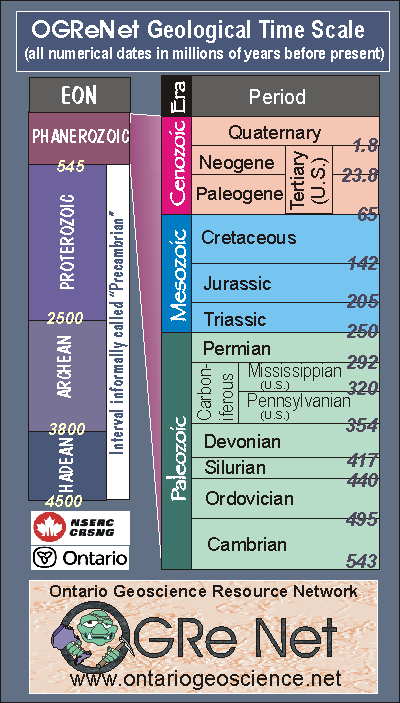
 The Geological Time Scale
The Geological Time Scale
How do we measure time? Most people would probably talk of units such as seconds, minutes, hours, days, years etc. Most geoscientists would probably respond to this question differently since they deal with much longer spans of time. Just imagine how long it takes to build a mountain ! Time spans involved in geological processes such as mountain building are measured in millions of years.
Planet Earth is at least 4.5 billion years old. Geoscientists have divided Earth’s history into a hierarchy of units that provides meaningful times frames within which events of the Earth’s past can be arranged. The resulting classification scheme, as depicted below is called the geological time scale.
The largest units within the geological time scale are eons, which span hundreds of millions of years to billions of years. From oldest to youngest, these eons are the Hadean, Archean, Proterozoic and Phanerozoic. The last eon, which began about 540 million years ago and extends to the present day, is called the Phanerozoic Eon. The Phanerozoic, meaning “well displayed life” is distinguished from the other eons by the abundance of fossils of complex living things that document major evolutionary trends.
The Phanerozoic Eon is divided into eras. From oldest to youngest, these eras are named the Paleozoic (ancient life), Mesozoic (middle life) and Cenozoic (recent life). As indicated by their names, the boundaries of eras mark times of major change in the history of complex life.
Each era is, in turn, divided into time units called periods. Within the Paleozoic era are the Cambrian, Ordovician, Silurian, Devonian, Carboniferous and Permian periods. Within the Mesozoic Era are the Triassic, Jurassic and Cretaceous periods. Finally, the Cenozoic Era contains the Paleogene, Neogene and Quaternary periods. In the United States, the Paleogene and Neogene are grouped together as the Tertiary Period. Each of these periods is characterized by a major change in life forms that is less profound than those marking boundaries of eras.
Finally, each of the periods can be divided into even smaller units called epochs. Within the Paleogene Period are the Paleocene, Eocene and Oligocene epochs. Within the Neogene Period are the Miocene and Pliocene epochs. The Quaternary Period contains the Pleistocene and Holocene epochs. The epochs of the other periods are simply termed early, middle and late (e.g. Late Devonian).
The geological time scale makes it much easier for geoscientists to communicate their ideas on major events in the Earth’s history. Instead of saying “the fossils I study are 144 to 65 million years old,” the person can say “I study Cretaceous fossils.” What’s the use in wasting time ? Life is just too short for that kind of nonsense !


